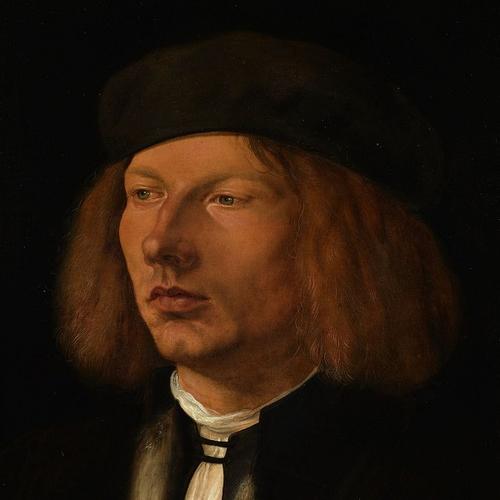-
1 of 253523 objects
Burkhard of Speyer (16th century) Signed and dated 1506
Oil on panel | 31.7 x 26.0 cm (support, canvas/panel/stretcher external) | RCIN 404418
-
Late in the summer of 1505 Dürer travelled to Venice where he stayed until early in 1507. His work and life there are recorded in ten letters to his friend Willibald Pirckheimer. In 1506 the German merchants in Venice who belonged to the confraternity of the Rosary commissioned an altarpiece, The Feast of the Rose Garlands, for the German church of San Bartolommeo (now Národni Galerie, Prague). According to the inscription on the painting, Dürer completed the work in five months. In a letter to Willibald Pirckheimer dated 23 September 1506 Dürer wrote that he would leave Venice in a month's time, 'but I must first take the portraits of some people I have promised'.
This painting is one of the portraits painted by the artist in Venice. The sitter appears as the fourth figure from the left in the The Feast of the Rose Garlands, where he wears identical clothes. He has been identified as Burkhard of Speyer on the basis of his resemblance to a miniature portrait (Schlossmuseum, Weimar) with the inscription 'Burcardus de Burcardis Spirensis 1506'. All three portraits record his distinctive nose, high cheekbones and small eyes in a three-quarter view, but the miniature is a half-length as opposed to just head and shoulders. In the altarpiece Burkhard is shown with ecclesiastical figures to the left of the Virgin. He may have been one of the German chaplains attached to San Bartolommeo. He may also have been related to Johannes Burkhard, from Alsace, Master of Ceremonies at the Vatican, and Bishop of Arte and Cività Castellana. Despite being placed with the ecclesiastics, however, Burkhard wears secular Venetian dress including the rounded Italian bonnet or beret and gown over a red under-jacket.
Dürer's work in Venice shows an interesting meeting of German and Venetian techniques. He would have been impressed by the rich and varied colours available in Venice and brilliantly exploited by Venetians such as the elderly Giovanni Bellini (c.1431/6-1516). Already painting with breadth and fluidity, he now combined vibrant colours in semi-transparent layers to sumptuous effect. His meticulous attention to detail prompted his friend Joachim Camerarius to write the legendary tale of how Bellini admired Dürer's skill, particularly the delicacy with which he drew individual hairs. Asking Dürer for a special brush to paint several fine hairs with one stroke, he was shown an ordinary brush.
For this portrait Dürer combined his exacting record of faces and mastery of line with Venetian colour. The head-and-shoulders format and sense of colour and light in this portrait were clearly influenced by Giovanni Bellini's late portrait style, for example in Portrait of a Young Man, possibly Pietro Bembo c. 1505 in the Royal Collection. It was thought the miniature was a copy of the painting, which therefore had been cut down. The vertical edges of the panel seem to have been tidied up, but there is no evidence that the painting has been cut, and the other portraits Dürer painted in Venice have the same close-up view of the sitter. The support of poplar or willow is Venetian, as is the gesso ground. This was modified by a translucent upper layer of a warm pinkish brown found on other German paintings of this period. The portrait's tonality struck Abraham van der Doort, who recorded it in the seventeenth century as a 'red faced mans picture'. The portrait is thinly painted so that the pink-brown ground can be seen in the shirt and in the modelling of the face, but the highlights are also warm in hue. Infrared reflectography and X-ray show that the edge of Burkhard's hat was adjusted on his brow and both shoulders lowered. Dürer manipulated and softened the shadows in the nose and neck with his thumb or fingers.
In the seventeenth century the painting was hung in the Chair Room at Whitehall, together with the king's most precious paintings, which included Dürer's Self Portrait (Museo del Prado, Madrid) and the portrait of his father (National Gallery, London).
Catalogue entry adapted from The Northern Renaissance. Dürer to Holbein, London 2011Provenance
Acquired by Charles I; recorded in the King's Chair Room at Whitehall in 1639 (no 29); sold for £60 to Ralph Grynder and others on 23 October 1651 from St James's Palace (no 51); recovered at the Restoration and listed in the King's Closet at Whitehall in 1666 (no 370)
-
Creator(s)
Acquirer(s)
-
Medium and techniques
Oil on panel
Measurements
31.7 x 26.0 cm (support, canvas/panel/stretcher external)
31.7 x 25.7 cm (image)
46.2 x 40.3 x 6.8 cm (frame, external)
Category
Object type(s)
Alternative title(s)
Burkhard von Speier (16th century)
Portrait of a young German, previously entitled
